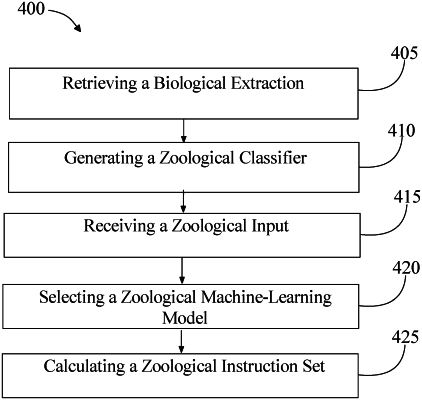| CPC G16H 20/60 (2018.01) [G06F 18/24 (2023.01); G06N 20/00 (2019.01); G06V 10/764 (2022.01); G06V 10/774 (2022.01); G06V 20/698 (2022.01); G16B 40/00 (2019.02); B01D 11/0207 (2013.01)] | 16 Claims |

|
9. An artificial intelligence method of generating zoological instruction sets from biological extractions, the method comprising:
retrieving, by a computing device, a biological extraction pertaining to an animal;
generating, by the computing device, a zoological classifier wherein the zoological classifier utilizes the biological extraction as an input and outputs a zoological profile;
receiving, by the computing device, a zoological input from a remote device wherein the zoological input identifies a zoological habit;
selecting, by the computing device, a zoological machine-learning model of a plurality of zoological machine-learning models utilizing the zoological input and the zoological profile, wherein:
the zoological machine-learning model comprises a supervised machine learning model;
the zoological machine-learning model utilizes the zoological input and the zoological profile as inputs and outputs a correlated zoological instruction set; and
selecting the zoological machine-learning model comprises:
generating an input classifier;
training the input classifier using input classifier training data comprising a plurality of zoological input data and a plurality of zoological profile data correlated to a plurality of corresponding zoological machine-learning model data;
classifying the zoological input to the zoological machine-learning model of the plurality of zoological machine-learning model using the trained input classifier; and
selecting the zoological machine-learning model from the plurality of zoological machine-learning models using the trained input classifier and the classification;
training, by the computing device, the selected zoological machine-learning model using zoological machine-learning model training data comprising a plurality of zoological input data set and a plurality of zoological profile data set correlated to a plurality of zoological instruction sets;
outputting, by the computing device, a zoological instruction set utilizing the trained selected zoological machine-learning model;
receiving, by the computing device, an instruction set input from a remote device;
comparing, by the computing device, the instruction set input and the zoological instruction set; and
updating, by the computing device, the zoological instruction set as a function of the comparison utilizing the trained selected zoological machine learning model.
|